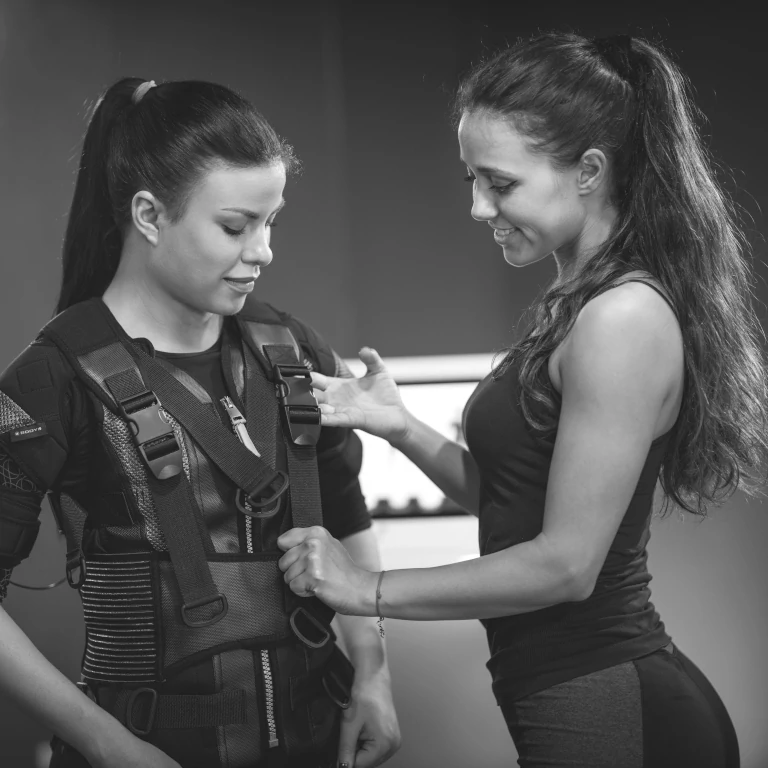

There are three significant types of muscles in the human body: skeletal muscle, smooth muscle, and cardiac muscle.
Skeletal muscles connect to the bones through tendons and incorporate nerves, blood vessels, and connective tissues to operate as a functional unit.
Every skeletal muscle contains skeletal muscle cells, which come together to form bundles of muscle fibres. During strength training, these fibres are stimulated to encourage hypertrophy or muscle growth (when combined with appropriate nutrition).
When you want to move, the nervous system sends a signal to the nerves in your skeletal muscles to shorten and contract. These contractions pull on the bones and joints, resulting in the desired movement.
Yes, to an extent.
When you perform any resistance exercise such as weightlifting, the repetition tears the muscle fibres in your body. Muscle growth occurs during recovery, when the body sends extra proteins (and other nutrients, including carbs and fats) to rebuild the torn muscles into something bigger and stronger.
Protein is made of numerous amino acids that form the building blocks of your muscle and other tissues. While the body can manufacture many different amino acids by itself, nine Essential Amino Acids (EAA) cannot be created by the body and must be consumed in our diet.
The amount of protein your body needs to build and repair skeletal muscle will vary slightly depending on your existing muscle mass and your daily activity levels, as well as the type and intensity of the physical activity you’re undertaking.
That said, in June 2017, the International Society of Sports Nutrition (ISSN) conducted a study into protein intake and muscle mass. They concluded that an overall daily protein intake of around 1.4 to 2.0 grams of protein per kg of body weight per day (g/kg/d) would be recommended to build and maintain muscle mass.
With these figures in mind, a person weighing 125lbs (57kilos) working to increase their LBM would need 57 x 1.4-2.0… Amounting to between 79.8 – 114 grams of protein per day.
While this might sound like a lot, high-protein food sources will help you reach the recommended protein intake more easily:
1 cup (140g) of chicken contains 43 grams of protein.
1 can of tuna contains up to 49 grams of protein.
1 glass of 2% milk contains 9-10 grams of protein.
The type and intensity of physical exercise will also influence how much protein it’s advisable to consume. For a rough guideline, aim for:
0.8 – 1.2 g/kg for regular activity
1.2 – 1.5 g/kg for endurance athletics
1.5 – 1.8 g/kg for strength or power athletics.
While it might be tempting to think more protein = more muscles, it’s not advisable to go too far over the recommended daily allowance for your muscle mass and activity levels.
In fact, a study was conducted involving participants to take part in resistance training. The control group consumed the recommended daily allowance of protein, while the study group ate five times as much. The study found no effect on body composition between the two groups, meaning that doubling or tripling your protein intake doesn’t mean more muscle gains.
While it’s true that meat provides an excellent source of protein and is packed full of the essential amino acids our bodies can’t produce, a vegan and vegetarian diet that’s rich in plant-based protein can also be highly beneficial.
There have been a few small-scale studies into the relationship between plant or meat-based proteins, muscle gain, and weight loss:
A small study compared resistance training-induced changes in body composition and skeletal muscle in older men with an omnivorous (meat) and Lacto-ovo vegetarian (meat-free) diet... Researchers found those consuming an omnivorous diet experienced greater fat-free mass and skeletal muscle mass gains when combined with resistance training than those consuming a meat-free diet.
A study of 74 men and women with type 2 diabetes – half on a vegetarian diet and the other on a typical diabetic diet – found that a vegetarian diet was almost twice as effective when it came to weight-loss compared to the conventional diet… However, this was accompanied by more significant muscle loss, particularly when combined with the participants’ normal exercise regimes.
Many plant-based protein sources can be just as effective as animal protein for promoting muscle gain.
A study in the Journal of Nutrition observed that rice protein has similar benefits to the body as whey protein supplements after resistance training.
To build muscle, chances are increasing your dietary protein is a sensible option. However, you should not replace all your calories with protein and neglect carbs and fat!
Carbs are essential for almost all body functions and are a vital energy source. They also help replace glycogen lost during physical exercise and aids insulin in transporting nutrients around the body.
Combining protein and carbs also limits post-exercise muscle breakdown and encourages the muscles to grow bigger and stronger.

EMS stands for Electrical Muscle Stimulation: a modern workout that uses electrical pulses instead of weights to create resistance during physical movements. This state-of-the-art training method is a highly effective way of building and sustaining muscle without putting strain on the joints, tendons, or ligaments.
Our Body Pulse Studio EMS sessions take just 20 minutes of your time, yet provide the results of six to eight hours of conventional workouts!
Because EMS training uses electrical pulses rather than weights and the movements are ultra-low impact, this workout is particularly effective for helping older individuals maintain and improve their fitness. It’s actually one of the safest workouts you can do.
What’s more, every Body Pulse Studio workout is tailor-made to suit your requirements. You’ll be working closely with one of our specially trained EMS personal trainers to create a fitness course that works for your goals and requirements.
Your personal trainer will only be working with a maximum of one other person, so they will always be on-hand to ensure you’re getting the most out of every session, in-line with any limitations you might need us to work around.
At Body Pulse Studio, we’re very aware of feeling like you’ve been working out forever and aren’t seeing any progress. To help with that, we start every course with a Body Composition scan and consultation using our state-of-the-art InBody™ 770 technology.
This technology accurately measures skeletal muscle mass, total body fat, visceral fat, metabolic rate, and a whole range of other key body composition metrics. We’ll then discuss the results with you and work with you to create the perfect fitness regime that suits your goals and requirements.
After 8/10 weeks of EMS training, you’ll be invited to use the InBody™ 770 scanner again, with a further consultation with one of our specialists to discuss your results.
Your first Body Pulse Studio EMS session is designed to provide a comprehensive introduction to EMS and what you can expect from your training. We ask that you allow for this to take 60 minutes, although your session may be completed faster than this.
The first thing that will happen in your initial EMS session is that you’ll be greeted by your personal trainer and EMS specialist. They will go through your health history and the consent forms with you.
Next, you’ll be asked to change into the special EMS workout suit. This intelligent outfit fits under the EMS bodysuit and is able to conduct electricity to enhance your workout.
Before you start your EMS training session, you’ll complete an InBody™ scan to measure your key biometrics.
Once your InBody™ scan is complete, your personal trainer will help fit you into the special EMS workout suit, wet down the electrodes on the EMS muscle stimulator, and connect you to the device.
Your personal trainer will then introduce you to the electrical pulses that you’ll experience during your workout and lead you through a short exercise routine to assess your current fitness levels.
Most clients start EMS training with one session per week, but many increase this to an EMS workout every four to five days.
Electrical Muscle Stimulation exercises have been used for years in orthopaedic rehab settings, thanks to the EMS devices’ low-impact muscle-building capacity. For most people suffering from pain in the joints, EMS training provides the perfect alternative to weights or cardio that might strain your already-painful joints.
Although EMS training is suitable for almost every adult over the age of 16, a few medical conditions would prevent someone from taking part in an EMS session.
If you have any of the following, or are pregnant, we cannot enrol you in EMS training:
EMS training is 100% pain-free!
Although Electrical Muscle Stimulation might sound daunting, it only uses low impulse frequencies that our bodies can barely feel.
You should be able to feel a difference in your body immediately after your first EMS workout. This will be a combination of endorphins, your circulation improving, and your posture immediately correcting thanks to the recent muscle activation.
You may experience some soreness after a couple of days, which is entirely normal and simply lets you know that your muscles have worked out.
An average gym workout tends to take one or two hours per session. To feel and see visible results, you would need to train at the gym three times a week, adding up to three hours or more.
At Body Pulse Studio, you can reap the benefits of three 90-minute conventional weights workouts in just 20 minutes!
Not only does this provide faster, more effective results that you can see and feel almost immediately, but it also means you need to spend less time in the gym and more time enjoying life!
Electrical Muscle Stimulation replicates the natural way our central nervous system sends electrical impulses to control our muscles.
With light, painless, electric impulses created by the EMS device, we can penetrate deeper into the muscle fibres to intensify the workout and reach layers of muscles that are tricky to activate using conventional exercise alone.
To achieve this stimulation, EMS electrodes are applied to the skin directly above the muscle to gently send electrical pulses through the muscle fibres. The effectiveness is increased when the user actively exercises while the device works.
You should eat two/three hours before an EMS training session to ensure you have plenty of energy for the workout. It’s also beneficial to consume a minimum of 300ml of water around 30-45 minutes before the session.
EMS training is one of the best ways to achieve your fitness goals fast, with almost unlimited benefits for participants.
Some of the principal benefits of EMS training include:
